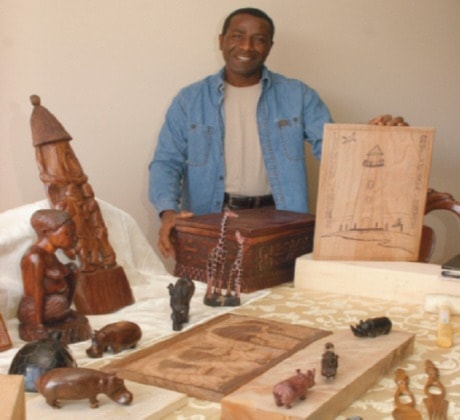Capturing the spirit of Sylvan Lake and creating the spirit of what we have is one of the goals of wood carver Edward Mutemwa who hopes to expand his hobby, a craft he learned in his native Zambia and throughout Africa.
He’s looking for a small space, perhaps eight to ten feet square, where he can set up his tools and work in peace on his creations during spare time. A place where he can store his finished or partially finished pieces and raw wood. “A place where I can express my feelings in wood and have continuity.”
Perhaps, Mutemwa suggested, if someone has a cabin that’s vacant in the winter but has power and heat, he’d offer to make sure it’s checked regularly while using it to work on his art.
“I have such a great passion to develop my art skills, continue to put forward finished products people can appreciate,” he said during an interview Friday.
Some Sylvan Lakers have already been exposed to his work through sales at Memorial Presbyterian Church.
Mutemwa has been in Sylvan Lake for the past five years, arriving straight from Zambia.
He explained that in 1976 he came to Canada on a youth exchange program. The first part of the program he was in Ontario while during the second part he came to Alberta where he lived with the Ferguson family in Pincher Creek.
He continued communicating with them and expressed a desire to come to Canada. Eventually an opportunity arose in Sylvan Lake to work for one of the family’s sons, Lane Ferguson at Cabinet Creations. “This family accorded me the opportunity, I’m forever grateful, emotionally grateful,” Mutemwa said. “His mother was the great lady behind my coming here.”
He spent over two years working for Ferguson and is now employed by a property management company doing maintenance work.
Mutemwa said he first started drawing and painting in primary school and continued as a teenager doing portraits and landscaping.
“People told me I did good work but I wasn’t satisfied for some reason. One day I started imagining my art as three dimensional. I met a man from the Republic of Zaire (Congo) who was doing both. I was excited and asked him, ‘how do you do stuff, draw and then make it three dimensional?’ He told me it was easy and I invited him to my home. We spent a full day at home and instead of explaining it, he made me do it.”
They started by discussing the idea then drawing it on a piece of mukwa, which is a hardwood. “He was explaining things and gave me a mallet and chisel, explained the wood grain.”
You can see the twinkle in Mutemwa’s eyes and hear his enthusiasm as he talks about his passion. He said, “I was excited about it, carefully following what he was doing. I could see it coming, started to see the contours … saw the woman taking shape.” Then he had to do the back ground. “I was so surprised and excited to have done a piece like that.”
His first carving was of a woman carrying something on her head.
That was in 1982.
“That man, his main tools were a mallet, chisels and sand paper. As I moved along I met other people doing different things.”
Now Mutemwa uses a hack saw, raspers and chisels. His work is finished with wax and very fine sandpaper. He never uses lacquer to create the lustre.
During part of his apprenticeship he spent a month or two in a village, going into the bush to find material for carving.
“I can see good potential in a piece of wood anywhere in the world, it’s a lot more than just looking at it,” Mutemwa said.
Interested in being diverse in his artwork, he travelled extensively across Africa, to Tanzania, the Masai, Zimbabwe, South Africa.
In Zambia, he explained, there are 73 tribes and nine provinces. “My idea was to expand myself so I wasn’t limited.” He travelled to many of those areas.
He spent time at the Muramba cultural village in Livingstone Town, the tourism capital of Zambia. There they were encouraged to “preserve, maintain and portray their culture”.
Where he comes from his tribe is involved in traditional carving. It’s also known as a water tribe. “Our life is based on water.” The traditional village is on the banks of the Zambezi River and every year they’re forced to move out of the fertile valley into the hills.
The Kuomboka traditional ceremony, in Lozi language, literally means “to get out of water”.
During the rainy times, “the water rises up to the village and finds you and sinks your home”, he said. People in that area have two homes — during the rainy season they move off of the flood plain to drier land and once the water goes they go back to the fertile land.
Mutemwa sees water here and feels a connection. And he believes in the potential for creating souvenirs for Sylvan Lake.
“I believe art is a great way to make people connect and remember where they’ve been.” He sees the lighthouse as a symbol of Sylvan Lake and people having visited here. That’s one of the ideas he’s contemplating. He’d like to do it in such a way that anywhere you see it you’ll know people have been to Sylvan Lake.
He’s also challenging himself with different types of wood, learning how to work with things like cherry, butternut and maple.
Another idea he’s thinking about is bears in very stances or showing various expressions.
Mutemwa would also be interested in talking to others with his interest in wood carving and perhaps forming a club or sharing a space. He may be contacted at his cell number, 403-506-7146.
